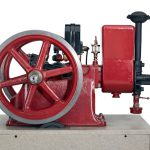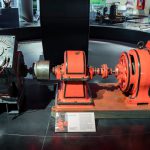Collecting the personal: stories of domestic energy and everyday life at the National Museum of Scotland
Article DOI: https://dx.doi.org/10.15180/180910
Abstract
Energise is one of ten award-winning new galleries at the National Museum of Scotland in Edinburgh. Aimed at a family audience, it explores the sources, generation, distribution and use of energy and questions how science and technology may transform how we power our lives in the future. This short case-study account details three objects in Energise around which we adopted a focus on personal stories that tell us about the experiences of users and developers.
Keywords
collecting, energy, museums, personal stories, Scotland
Collecting the personal
https://dx.doi.org/10.15180/180910/002Figure 1 shows an advertisement for a ‘Hired Man’ petrol engine as used in early twentieth-century agriculture. In this case it is being used to power a washing machine, at a glance demonstrating two important factors in the understanding of technology and society. Firstly, it displays the reconfiguration of work-life patterns that such devices catalysed. Secondly, the image presents the personal stories that accompany individual artefacts. How did the family depicted afford this cutting-edge equipment? Was the user really emancipated?
This short discussion presents case-studies in the collection of personal stories in technology, as a contextual contribution to the Material Cultures of Energy project – a four-year AHRC funded project based at Birkbeck, University of London, examining the impact of energy transitions in the past, present and future. We explore three examples of how the collection and interpretation of energy objects has evolved in National Museums Scotland: the ‘Hired Man’ engine mentioned above, as well as a Parsons turbine and solar-light kit. All three are displayed in Energise, one of ten award-winning galleries that opened in the National Museum of Scotland in Edinburgh in July 2016.
Energise is divided into four sections: sources of energy; using energy; distributing energy; and generating energy. The largest of the 121 objects in the gallery is an isolator from the Portobello substation in Edinburgh, used to shut off the electrical circuit making it safe to repair faults. It was part of the first section of the National Grid to be switched on in 1930. Featured renewable energy technologies include the tip of a 50-metre wind turbine blade used at the Griffin windfarm in Perthshire, the first licensed hydrogen fuel cell car in the UK (Reva hydrogen powered car, by PURE Energy, 2003), and a 4-metre long wave tank created especially for the Museum by wave tank designers Edinburgh Designs Ltd. In the opening ‘Generating Energy’ section we focus on technologies designed to generate electricity, including an Edison electric light dynamo (1882) displayed alongside a sectioned Parsons turbo-generator manufactured by Clarke, Chapman, Parsons and Co. in 1889.
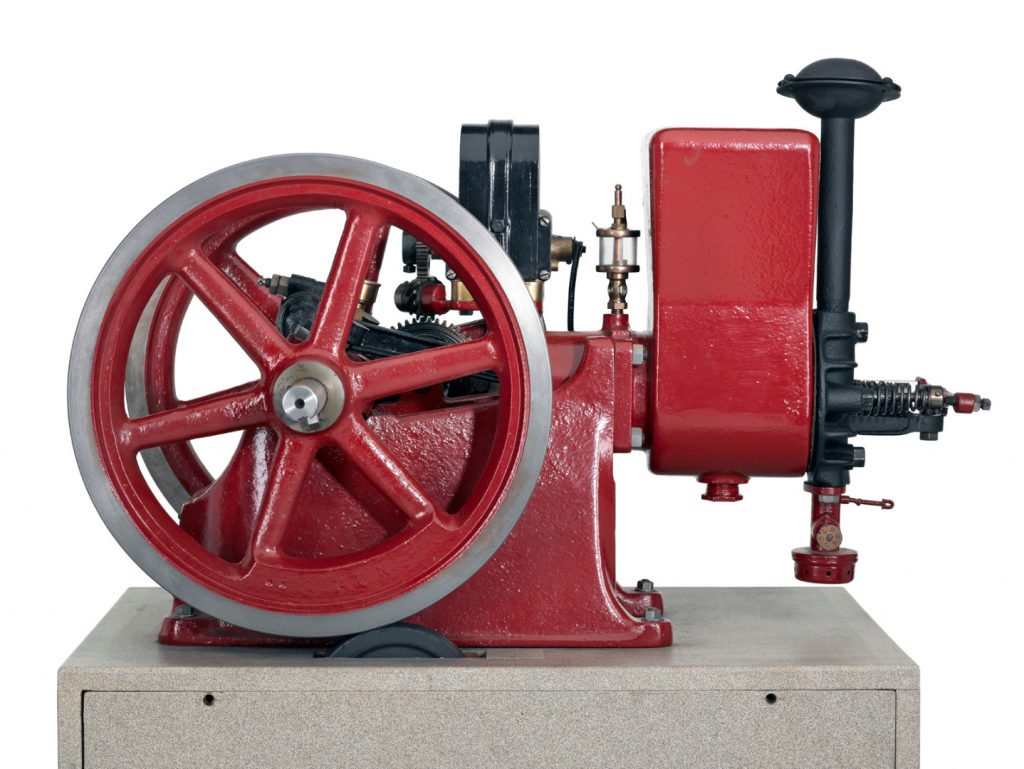
We picked out the ‘Hired Man’ to open with because it provides a telling example of how museums collected domestic technology in the 1960s and it reflects the curatorial trend of the time which emphasised the story of invention, particularly British invention, rather than personal stories or broader narratives of use. The curatorial file created for this engine at the time of collection tells us how it was then perceived, providing copious details on the technical aspects of the machine but only a short note to indicate that it had been used to power a joiner’s shop in Fife until the mid-1960s. ‘Until recently this engine was still being used to power tools in a joiner’s shop’, a rare note on usage revealed, ‘and it was seen running by Mr R W Plenderleith [Robert Plenderleith, Keeper of Technology 1966] during the summer of 1966 before being purchased by the Museum.’
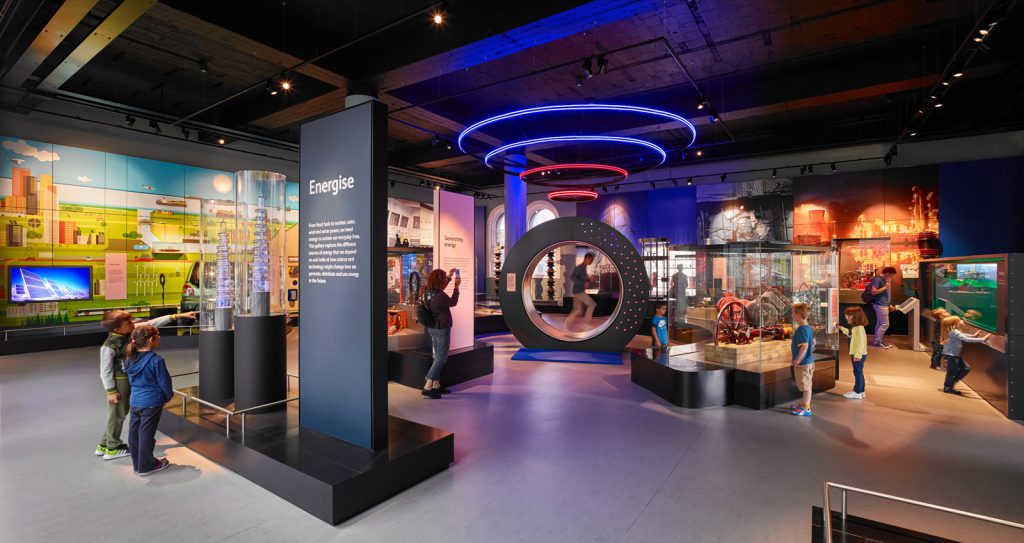
By contrast, what links the objects in Energise and other displays throughout the new science and technology suite is the objective to exhibit human stories of everyday life in varying global contexts alongside scientific concepts and technological developments. It was therefore important to draw out the human elements of the story of the ‘Hired Man’, and more generally to showcase objects that can tell engaging stories about the experience of users and developers and the social impact of those technologies.
As a contribution to Material Cultures of Energy, in the rest of this short discussion paper we will present two other domestic-energy objects in Energise: a solar-light kit and a hydro turbine. Like the ‘Hired Man’, they are deceptively humble but nevertheless demonstrate important changes in both everyday usage and museum collecting practices. Domestic energy technology forms a significant part of the exhibition which aims to make our visitors more aware of their own energy usage at home, work or school.
Although from different continents and dating almost a century apart, the solar-light kit and the turbine are connected; both provided innovative off-grid solutions to the problem of gaining easy and reliable access to, and employment of, electricity. On display in Energise, we relate this to more local Scottish stories – the Isle of Eigg (Scottish Inner Hebrides) has a micro-grid powered by three generators in combination with solar and wind energy. Nevertheless, their cultural and social contexts of use contrast sharply. The solar-light kit was employed in regions of extreme poverty in Bangladesh, and the hydro-turbine was used to power a grand Scottish country estate.
In each case we explore how and why these objects and the stories associated were collected and what themes they were intended to display. What lessons can be learned from the experience of displaying them? Can we humanise technology?
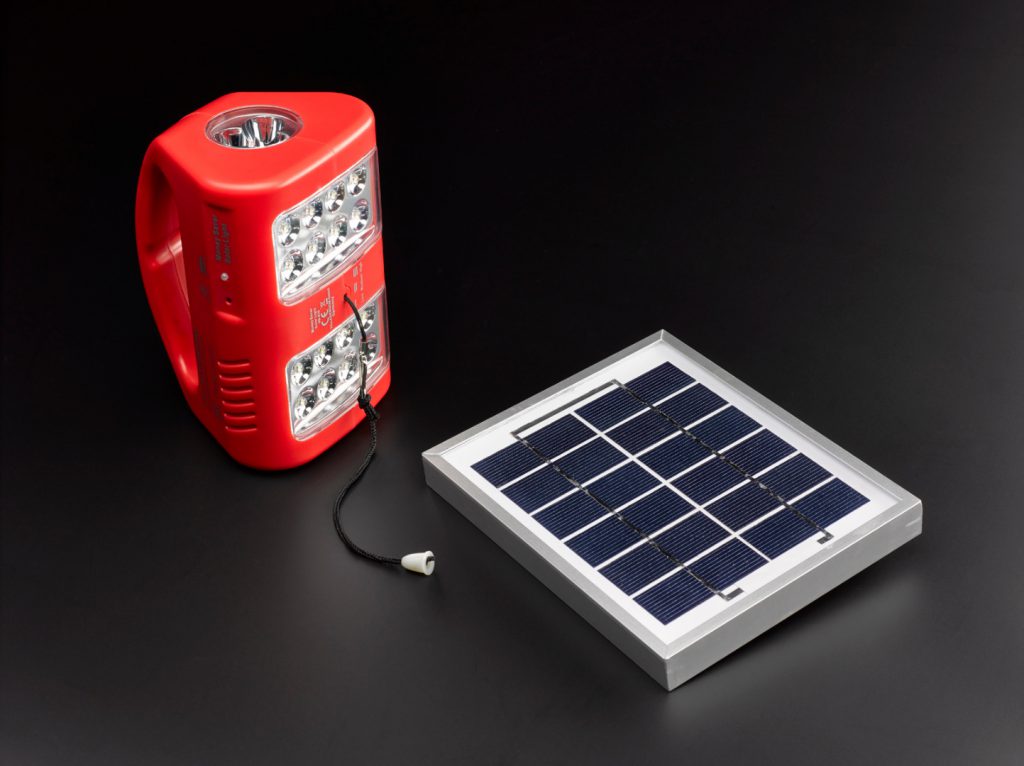
It was a priority that Energise conveyed that not everyone in the world has easy and reliable access to electricity. Developed in Bangladesh in 1996, the Grameen Shakti solar energy scheme provides small loans to householders in remote and rural areas to enable them to replace kerosene-fuelled lighting with solar panels. The scheme facilitated the installation of more than two million solar home systems, thus saving fuel and reducing dangerous fumes and fire risks. Grameen Shakti made initial contact with National Museums Scotland, following a previous collaboration that involved collecting mobile telephones. Developed by the German social company Villageboom in Münster, the light kit is made up of a small solar panel and a lamp/charger. This relatively simple technology is changing work patterns, improving business prospects and enhancing health and safety in off-grid areas.
This then drew our attention to their work on solar panels and led us to examine the case-studies provided by Grameen Shakti. Living forty kilometres from Dhaka, solar kit user Rasheda Begum explained that she no longer needs to waste time cleaning kerosene lamps, there is now no problem of smoke in the room, and her daughter can now study in the evenings – something which proved hard under the kerosene lamp-light. They also used the solar unit to power a television and a fan and consequently feel that the unit has vastly improved their quality of life. Others reported the benefits of having LED lights as a security deterrent in their cattle and chicken sheds adjacent to their houses. Grocer Nural Islam described how his shop has benefitted greatly from solar power. He now has a television in his shop which shows daily dramas; locals crowd in to view and his sales have increased considerably. He can also extend opening hours, again increasing profits. On gallery we seek to tell how this solar kit transforms lives.
Grameen Shakti’s system is not necessarily unique. There are similar systems in other countries, such as the ‘Scotland lights up Malawi’ project. But Grameen Shakti is home grown, made by and for the people of Bangladesh with the objective of alleviating extreme poverty through micro-credit. Engineers are trained to be ‘social engineers’ who go from place to place demonstrating the technology and training local young people to be technicians so that all the after-sales support customers require is close at hand.
These solar panels are an example of collecting not only the company’s story and rationale, but also capturing personal stories and local usage, giving a sense of how technology transforms day-to-day lives. This marks a significant shift in focus from capturing the story of invention as exemplified by the ‘Hired Man’. It was important for us that our interpretation captures these stories. ‘Hired Man’ has been made a working interactive. Users push a button and see it in action, so rather than providing facts and figures we emphasise the impact of such engines, which saved labour. The solar-kit’s label shows a photograph of users in Bangladesh, although does not refer to named users. This is how we can present the personal and present human engagement with technologies which at first glance may seem impersonal or mundane.
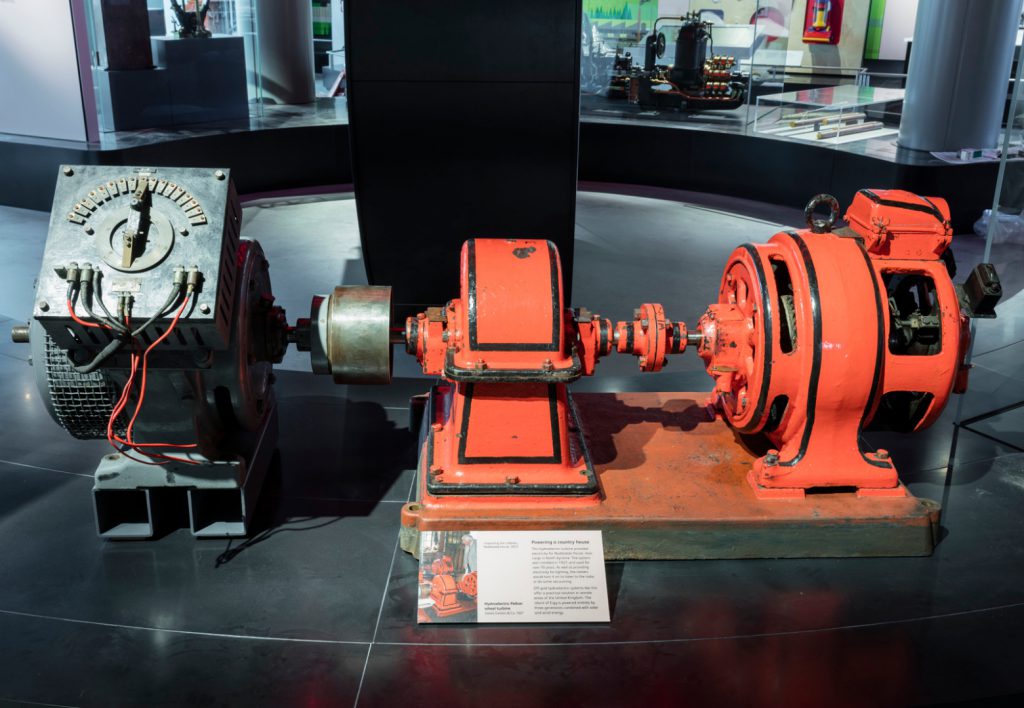
The final object in our trilogy of personal stories is a small Gilkes Pelton wheel hydroelectric turbine, one of a pair installed in Noddsdale Estate near Largs (Ayrshire) in 1927. The system was used to light the main house and four ancillary cottages. The owners described how they would turn it on to provide the power to listen to the radio or to vacuum. The turbines were in use for almost eighty years – this is also a story of the longevity of a particular type of technology. ‘It belongs to an age when things were made to last,’ reflected its final user, Peter Robertson (who was five years old when the turbines were installed), ‘in strict contrast to so much that is made today, which is designed to have a short life.’ On gallery the interpretation panel shows a photograph of Robertson with the turbine, with the interpretation focusing on the social context of use – highlighting where it was used and how it could affect the lives of those around it.
The turbine was still working in 2007 when the electrical system had to be modernised and the house was converted to mains electricity. Peter told us in 2015:
The old machinery was running sweetly up until its last day of operation. It was replaced, because the house had to be rewired for 240V AC against the 110V DC of the 1920s and modern machinery could make better use of the natural resources available. The old machines had a maximum output of some 6.5 kW, whereas the replacement is designed to produce 50 kW.
A new hydroelectric system has since been installed on the estate to provide power both for their use and to sell back to the grid.
In the process of collecting we were privileged to be able to engage with Peter and his family. We visited the site (including the new powerhouse which was built in 2007 as a replacement for the old turbine), listened to him recall personal memories about life and work at the house, and enjoyed meeting with the family and a tour of the estate. He speaks fondly of using and maintaining the turbine, which formed part of his family’s daily life for almost eighty years. He was delighted to have the opportunity to see it on display in the Museum (Figure 6) and noted how pleased he was to see that we hadn’t ‘tarted it up’: it still looked how he remembered it in use.
This unassuming artefact may be overshadowed by some of the more eye-catching displays but it offered a remarkable opportunity to acquire a display-sized turbine, thereby emphasising the importance of this technology, while also collecting the user-story of the habits and daily routines surrounding the object. Inherent in the history of this turbine are the practices developed by the owners to use the resource effectively and also practices imposed on them by the technology itself, determining when and how it could be used. The same technology is employed in hydroelectric power stations, but at a scale that would be too vast to collect or display in most cases.
In conclusion, by collecting the specific stories surrounding everyday artefacts Energise seeks to demonstrate the reconfiguration of work-life patterns across the twentieth century, and across continents. But these examples also remind us of the limitations of what our new galleries can achieve. Summative evaluation revealed that only a small proportion of visitors’ dwell-time in this gallery was devoted to these displays; the interactives, such as the ‘Energy Wheel’ that dominates the space, are much more popular. Also, a story panel or object-text with its limited word count can only convey a fraction of the life on an object and its maker or user. Within the expected spatial and thematic constraints of label writing, we were unable to detail specific personal stories such as Rasheda Begum and Nural Islam’s. Yet they are recorded in our collection and remain available to researchers or for incorporation into future displays. This is why we need to continue to capture the knowledge of the people involved and their personal stories. This approach ranges from broad oral histories to more focused projects such as our 2017 exhibition Age of Oil, which explored the decommissioning of oil platforms through the personal experiences of artist Sue Jane Taylor.
Museums deal in materiality through the artefacts they collect, store, interpret and display. The associated stories of human experience tell us a great deal about how we used energy in the past, how that is changing, and why the domestic context is important. The depth of the energy collections at National Museums Scotland also allow us to consider energy transitions over time, from historic dynamos and coal samples, to the National Grid, to energy-saving devices. It would be profitable to explore the role of artefacts and museums further in the context of comparative projects like Material Cultures of Energy. How can we better capture and display these material concepts? How do we continue to capture and reflect user practice today? How do we remain relevant to our audiences? Are we successful in engaging visitors with the changing sources and use of energy over time, and do they actually reflect on their own energy use as a result?





